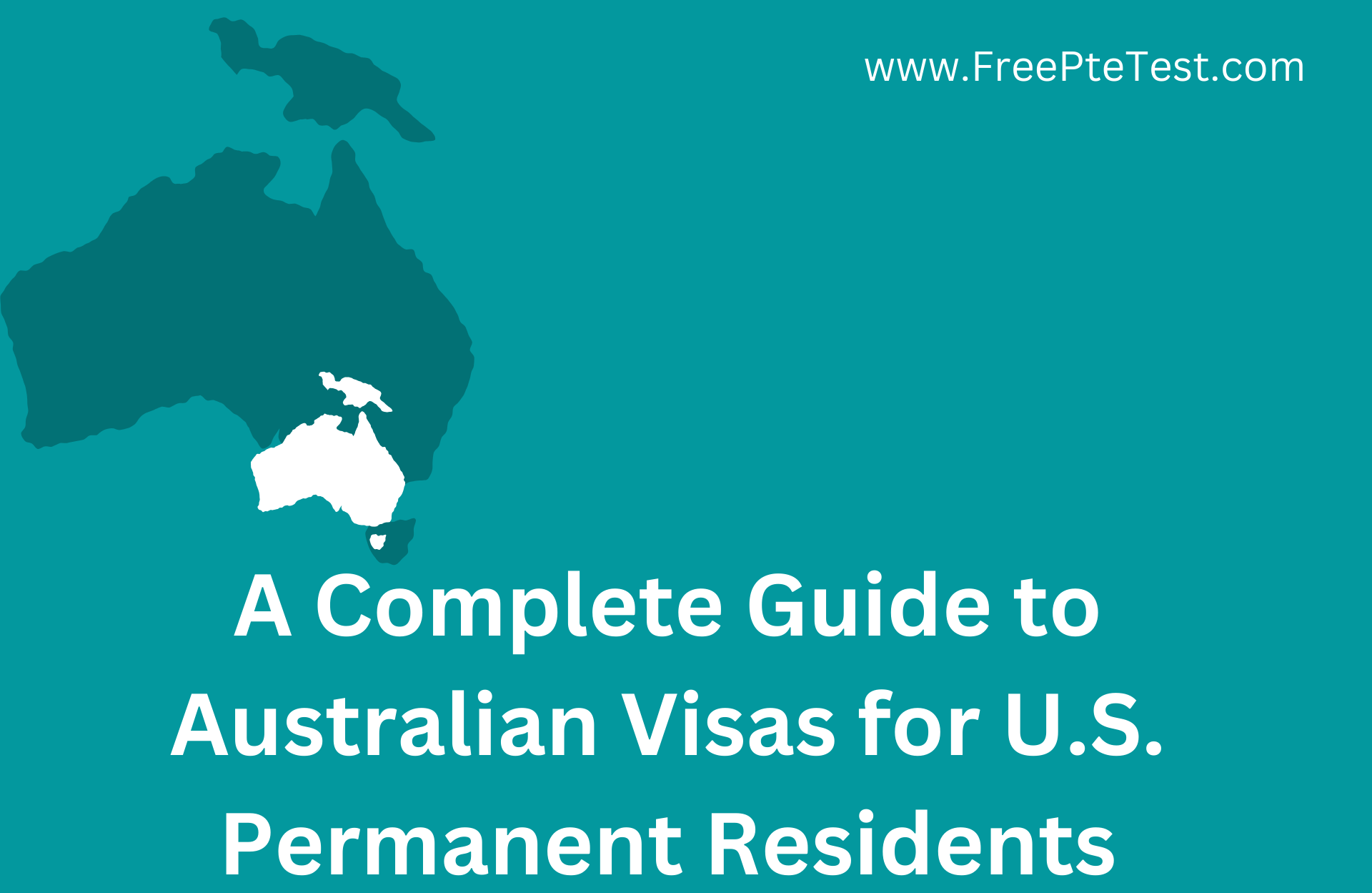Australian Visas for US Permanent Residents seeking new horizons and a change of scenery, Australia presents an enticing opportunity. With its diverse landscapes, vibrant cities, and a robust economy, Australia has become a preferred destination for individuals looking to start a new chapter in their lives.
However, the journey to Australian residency involves understanding the intricacies of the visa application process. In this comprehensive guide, we will explore the various Australian visa options available to U.S. permanent residents, offering valuable insights to ease the transition.
Understanding the Basics
Before delving into the specific visa options, it’s crucial to grasp the fundamental aspects of Australia’s immigration system. Australia offers different types of visas catering to various purposes, such as work, study, family reunion, and skilled migration. Each visa category has its eligibility criteria, application process, and duration.
- Temporary Visas:
- Visitor Visa (Subclass 600): Ideal for those looking to explore Australia for short-term purposes, such as tourism, business meetings, or visiting family and friends.
- Student Visa (Subclass 500): Tailored for individuals pursuing full-time courses in registered Australian institutions.
- Permanent Visas:
- Skilled Migration Visas: Aimed at individuals with specific skills and qualifications in demand in the Australian labor market.
- Family Visas: For those seeking to reunite with close family members who are Australian citizens or permanent residents.
Now, let’s explore some of the key visa options for U.S. permanent residents interested in making Australia their home.
Skilled Migration Visas
Australia’s Skilled Migration Program is designed to attract individuals with skills that contribute to the country’s economy. The General Skilled Migration (GSM) visas are points-based and assess factors like age, English language proficiency, education, and work experience.
- Skilled Independent Visa (Subclass 189):
- This visa is for skilled workers who are not sponsored by an employer, state, or territory, making it an excellent option for U.S. permanent residents seeking independent migration.
- Applicants must submit an Expression of Interest (EOI) and be invited to apply based on their points score.
- Skilled Nominated Visa (Subclass 190):
- Applicants must also submit an EOI and receive an invitation to apply, with additional points awarded for state or territory nomination.
- Skilled Work Regional (Provisional) Visa (Subclass 491):
- An alternative for those who are nominated by a state or territory or sponsored by an eligible relative living in a designated regional area.
- This visa allows holders to live and work in regional Australia for up to five years.
Family Visas
Australia prioritizes family reunification, offering various visa options for U.S. permanent residents looking to join their Australian citizen or permanent resident family members.
- Partner Visa (Subclasses 820 and 801):
- Designed for spouses or de facto partners of Australian citizens or permanent residents.
- The application process involves a two-stage process, starting with a temporary visa (Subclass 820) and progressing to a permanent visa (Subclass 801) after a waiting period.
- Forerunner/Parent Visa (Subcategories 103, 143, 173, 804, 864):
- For parents of Australian citizens or permanent residents who wish to join their children in Australia.
- Different subclasses cater to onshore and offshore applicants, with varying processing times and eligibility criteria.
- Child Visa (Subclasses 101, 102, 445, 802):
- Intended for dependent children of Australian citizens or permanent residents.
- The applicable subclass depends on whether the child is applying from inside or outside Australia.
Temporary Work Visas
For U.S. permanent residents seeking employment opportunities in Australia, temporary work visas provide a pathway to gain valuable work experience.
- Temporary Skill Shortage Visa (Subclass 482):
- Allows skilled workers to be sponsored by an approved employer for a position that cannot be filled by an Australian worker.
- The duration of the visa depends on the nominated occupation and the employer’s needs.
- Employer Nomination Scheme (ENS) Visa (Subclass 186):
- Requires employer sponsorship and meeting specific eligibility criteria.
Applying for an Australian Visa
Navigating the Australian visa application process can be complex, but thorough preparation and understanding the requirements can enhance the chances of success.
- Expression of Interest (EOI):
- For skilled migration visas, applicants must submit an EOI through the SkillSelect online system.
- Invitation to Apply (ITA):
- Based on the EOI, applicants may receive an ITA to lodge a formal visa application.
- It’s crucial to submit the application within the specified timeframe to avoid missing the opportunity.
- Skills Assessment:
- Many skilled migration visas require a positive skills assessment from a relevant assessing authority.
- This process verifies that the applicant’s qualifications and experience meet Australian standards for their nominated occupation.
- English Language Proficiency:
- Most skilled migration visas require proof of English language proficiency through standardized tests like IELTS or PTE.
- Health and Character Requirements:
- All visa applicants must meet health and character requirements, which may involve medical examinations and police clearances.
- Biometrics and Interviews:
- Some visas may require biometric data, and applicants may be subject to interviews as part of the assessment process.
Financial Considerations
Moving to Australia involves financial planning, and applicants need to consider various costs associated with the visa application process and settlement in Australia.
- Visa Application Fees:
- Visa application fees vary depending on the type of visa and the applicant’s circumstances.
- It’s essential to budget for these fees and be aware of any additional charges, such as those for family members included in the application.
- Health Insurance:
- Temporary visa holders are required to have health insurance, and it’s advisable for permanent residents as well.
- Research and choose a health insurance plan that suits individual and family needs.
- Settlement Costs:
- Initial settlement costs may include accommodation, transportation, and other essentials.
- Planning for these costs can ease the transition to a new country.
Conclusion
Embarking on the journey to Australia as a U.S. permanent resident requires careful consideration of visa options, eligibility criteria, and the application process. Whether seeking skilled migration, family reunion, or temporary work opportunities, understanding the nuances of the Australian immigration system is paramount.
As the landscape of immigration policies can change, it’s crucial to stay updated with the latest information from official government sources. Engaging with migration agents or seeking professional advice can also provide valuable insights and guidance tailored to individual circumstances.
Australia’s welcoming culture, diverse communities, and thriving economy make it an appealing destination for those looking to build a new life. With careful planning and a well-executed visa application, U.S. permanent residents can turn their Australian dreams into reality.
FAQs on Australian Visas:
Q1. What are the main types of visas available for U.S. permanent residents seeking to move to Australia?
Australia offers a range of visas, including Skilled Migration Visas, Family Visas, and Temporary Work Visas. Skilled Independent Visa (Subclass 189), Skilled Nominated Visa (Subclass 190), Partner Visa (Subclasses 820 and 801), and Temporary Skill Shortage Visa (Subclass 482) are among the popular options.
Q2. How does the Skilled Migration Program work, and what is an Expression of Interest (EOI)?
The Skilled Migration Program is a points-based system designed to attract skilled workers to contribute to Australia’s economy. An Expression of Interest (EOI) is an online form where applicants detail their skills, qualifications, and other relevant information. Based on the EOI, applicants may be invited to apply for a visa.
Q3. What is the difference between a temporary and permanent visa?
Temporary visas, such as the Temporary Skill Shortage Visa (Subclass 482), allow individuals to live and work in Australia for a specified period. Permanent visas, like the Skilled Independent Visa (Subclass 189), provide a pathway to Australian permanent residency, allowing individuals to settle in the country permanently.
Q4. Can U.S. permanent residents bring their family members to Australia?
Yes, family reunion is a significant aspect of Australia’s immigration policy. Partner visas (Subclasses 820 and 801), Parent visas (Subclasses 103, 143, 173, 804, 864), and Child visas (Subclasses 101, 102, 445, 802) are available for family members of Australian citizens or permanent residents.
Q5. What is the two-stage process for Partner visas, and how does it work?
The Partner visa process involves two stages. First, applicants apply for a temporary visa (Subclass 820). After a waiting period, they can then apply for the permanent visa (Subclass 801). This two-stage process allows individuals to live and work in Australia with their partner before obtaining permanent residency.
Q6. What are the English language proficiency requirements for skilled migration visas?
Most skilled migration visas require proof of English language proficiency through recognized tests like IELTS or PTE. The required score varies depending on the visa subclass and individual circumstances.
Q7. Are health and character assessments mandatory for all visa applicants?
Yes, health and character assessments are mandatory for all visa applicants. This ensures that individuals entering Australia meet health standards and have good character. Medical examinations and police clearances are commonly part of the assessment process.
Q8. What financial considerations should U.S. permanent residents be aware of when moving to Australia?
U.S. permanent residents should budget for visa application fees, health insurance costs, and initial settlement expenses such as accommodation and transportation. Understanding the financial aspects of the move is crucial for a smooth transition.
Q9. Can U.S. permanent residents seek professional advice or assistance during the visa application process?
Yes, seeking professional advice from migration agents or consultants is a wise decision. Professionals can provide tailored guidance, ensuring that applicants meet all requirements and navigate the application process successfully.
Q10. How often do immigration policies change, and how can applicants stay updated?
Immigration policies can change, and it’s essential for applicants to stay informed. Regularly checking official government sources and subscribing to updates from the Department of Home Affairs can help individuals stay abreast of any changes in immigration policies.
Navigating the Australian visa process requires careful consideration, planning, and adherence to the latest guidelines. By addressing common questions and concerns, U.S. permanent residents can embark on their journey to Australia with confidence and clarity.



